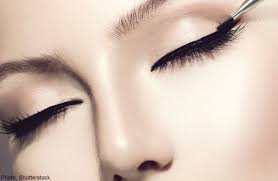Toronto, Apr 2: Women who apply eyeliner on the inner eyelid run the risk of contaminating the eye and causing vision trouble, a new study has warned.
This is the first study to prove that particles from pencil eyeliner move into the eye.
 Researchers used video recordings to observe and compare the amount of eyeliner particles that migrated into the tear film - the thin coating protecting the eye - after applying makeup in different styles.
Researchers used video recordings to observe and compare the amount of eyeliner particles that migrated into the tear film - the thin coating protecting the eye - after applying makeup in different styles.
“We noticed that the makeup migration happened quicker and was greater when eyeliner was put on the inner lid margin,” said Alison Ng, a scientist at the University of Waterloo.
Each participant wore glitter eyeliner outside the lash line, and then on the inner lid area closer to the eye, or along the waterline.
The vision scientists found that within five minutes, between 15 and 30 per cent more particles moved into the eye’s tear film when subjects applied eyeliner to the inside of the lash line, compared to outside it.
The makeup also moved more quickly into the eye when eyeliner was applied inside the lash line.
As time passes, the amount of makeup entering the tear film steadily drops and by two hours, there was a negligible amount of eyeliner left.
However, Ng, who directed the study when she was at Cardiff University in Wales, and her colleagues say eyeliner can alter the tear film, adding to discomfort.
Eyeliner ingredients
Eyeliner ingredients commonly include waxes, oils, silicones and natural gums to help eyeliner stick to eyelids and last for prolonged periods. It has to adhere through blinking, sweating and the secretion of natural oils.
Makeup that enters the tear film may cause discomfort for those with sensitive or dry eyes. But the eyeliner waxes and oils can also adhere to contact lenses and build up if used for more than one day.
Resulting complications include irritation and redness, introduction of harmful bacteria from the eyeliner, and in some cases, eye infections or blurred vision.
“People who wear contact lenses are most likely to notice some problems,” said Ng.
“If they have eyeliner stuck to their lenses, increasing deposits might cause vision disruption as the lens becomes cloudier,” said Ng.
While this study did not examine the bacterial aspect of makeup contamination to the eye, Ng notes that previous studies do show that old eye makeup can harbour bacteria.
“If you thoroughly sharpen your pencil eyeliner before each application and get rid of the stuff that’s stuck to the end, you’ll have a fresh tip which can help prevent infection,” said Ng.
“With twist-up eyeliner, cut some off the end before each use. And always make sure to fully remove eye makeup before bed,” Ng added.
The findings appear in the journal Eye and Contact Lens Science and Clinical Practice.





Comments
Add new comment